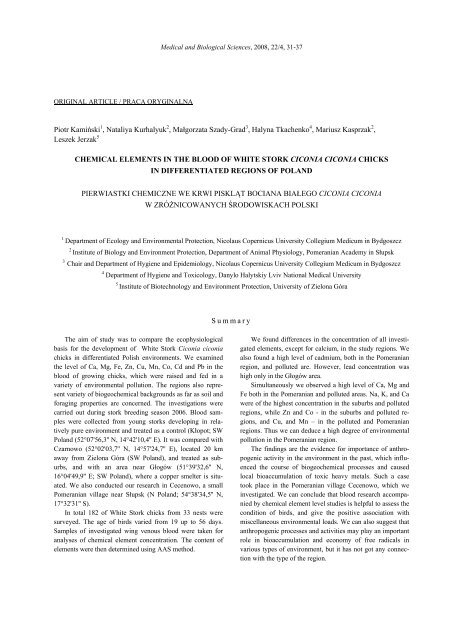medical and biological sciences - Collegium Medicum - Uniwersytet ...
medical and biological sciences - Collegium Medicum - Uniwersytet ...
medical and biological sciences - Collegium Medicum - Uniwersytet ...
You also want an ePaper? Increase the reach of your titles
YUMPU automatically turns print PDFs into web optimized ePapers that Google loves.
Medical <strong>and</strong> Biological Sciences, 2008, 22/4, 31-37ORIGINAL ARTICLE / PRACA ORYGINALNAPiotr Kamiński 1 , Nataliya Kurhalyuk 2 , Małgorzata Szady-Grad 3 , Halyna Tkachenko 4 , Mariusz Kasprzak 2 ,Leszek Jerzak 5CHEMICAL ELEMENTS IN THE BLOOD OF WHITE STORK CICONIA CICONIA CHICKSIN DIFFERENTIATED REGIONS OF POLANDPIERWIASTKI CHEMICZNE WE KRWI PISKLĄT BOCIANA BIAŁEGO CICONIA CICONIAW ZRÓŻNICOWANYCH ŚRODOWISKACH POLSKI1Department of Ecology <strong>and</strong> Environmental Protection, Nicolaus Copernicus University <strong>Collegium</strong> <strong>Medicum</strong> in Bydgoszcz2Institute of Biology <strong>and</strong> Environment Protection, Department of Animal Physiology, Pomeranian Academy in Słupsk3Chair <strong>and</strong> Department of Hygiene <strong>and</strong> Epidemiology, Nicolaus Copernicus University <strong>Collegium</strong> <strong>Medicum</strong> in Bydgoszcz4 Department of Hygiene <strong>and</strong> Toxicology, Danylo Halytskiy Lviv National Medical University5Institute of Biotechnology <strong>and</strong> Environment Protection, University of Zielona GóraSummaryThe aim of study was to compare the ecophysiologicalbasis for the development of White Stork Ciconia ciconiachicks in differentiated Polish environments. We examinedthe level of Ca, Mg, Fe, Zn, Cu, Mn, Co, Cd <strong>and</strong> Pb in theblood of growing chicks, which were raised <strong>and</strong> fed in avariety of environmental pollution. The regions also representvariety of biogeochemical backgrounds as far as soil <strong>and</strong>foraging properties are concerned. The investigations werecarried out during stork breeding season 2006. Blood sampleswere collected from young storks developing in relativelypure environment <strong>and</strong> treated as a control (Kłopot; SWPol<strong>and</strong> (52°07'56,3'' N, 14°42'10,4'' E). It was compared withCzarnowo (52°02'03,7'' N, 14°57'24,7'' E), located 20 kmaway from Zielona Góra (SW Pol<strong>and</strong>), <strong>and</strong> treated as suburbs,<strong>and</strong> with an area near Głogów (51°39'32,6'' N,16°04'49,9'' E; SW Pol<strong>and</strong>), where a copper smelter is situated.We also conducted our research in Cecenowo, a smallPomeranian village near Słupsk (N Pol<strong>and</strong>; 54°38'34,5'' N,17°32'31'' S).In total 182 of White Stork chicks from 33 nests weresurveyed. The age of birds varied from 19 up to 56 days.Samples of investigated wing venous blood were taken foranalyses of chemical element concentration. The content ofelements were then determined using AAS method.We found differences in the concentration of all investigatedelements, except for calcium, in the study regions. Wealso found a high level of cadmium, both in the Pomeranianregion, <strong>and</strong> polluted are. However, lead concentration washigh only in the Głogów area.Simultaneously we observed a high level of Ca, Mg <strong>and</strong>Fe both in the Pomeranian <strong>and</strong> polluted areas. Na, K, <strong>and</strong> Cawere of the highest concentration in the suburbs <strong>and</strong> pollutedregions, while Zn <strong>and</strong> Co - in the suburbs <strong>and</strong> polluted regions,<strong>and</strong> Cu, <strong>and</strong> Mn – in the polluted <strong>and</strong> Pomeranianregions. Thus we can deduce a high degree of environmentalpollution in the Pomeranian region.The findings are the evidence for importance of anthropogenicactivity in the environment in the past, which influencedthe course of biogeochemical processes <strong>and</strong> causedlocal bioaccumulation of toxic heavy metals. Such a casetook place in the Pomeranian village Cecenowo, which weinvestigated. We can conclude that blood research accompaniedby chemical element level studies is helpful to assess thecondition of birds, <strong>and</strong> give the positive association withmiscellaneous environmental loads. We can also suggest thatanthropogenic processes <strong>and</strong> activities may play an importantrole in bioaccumulation <strong>and</strong> economy of free radicals invarious types of environment, but it has not got any connectionwith the type of the region.
















